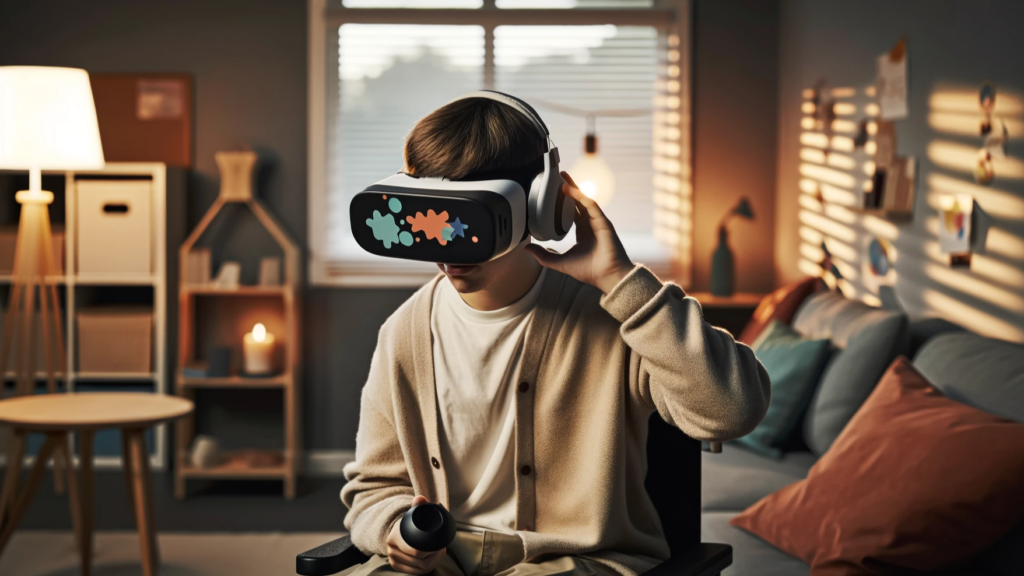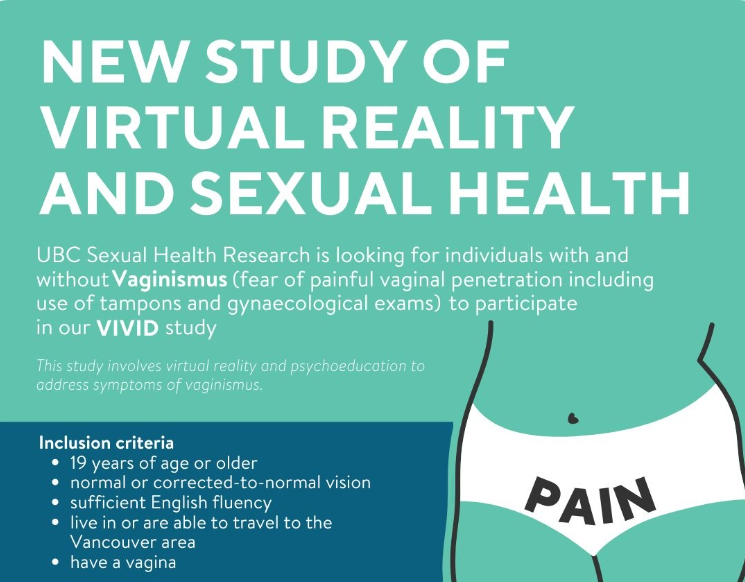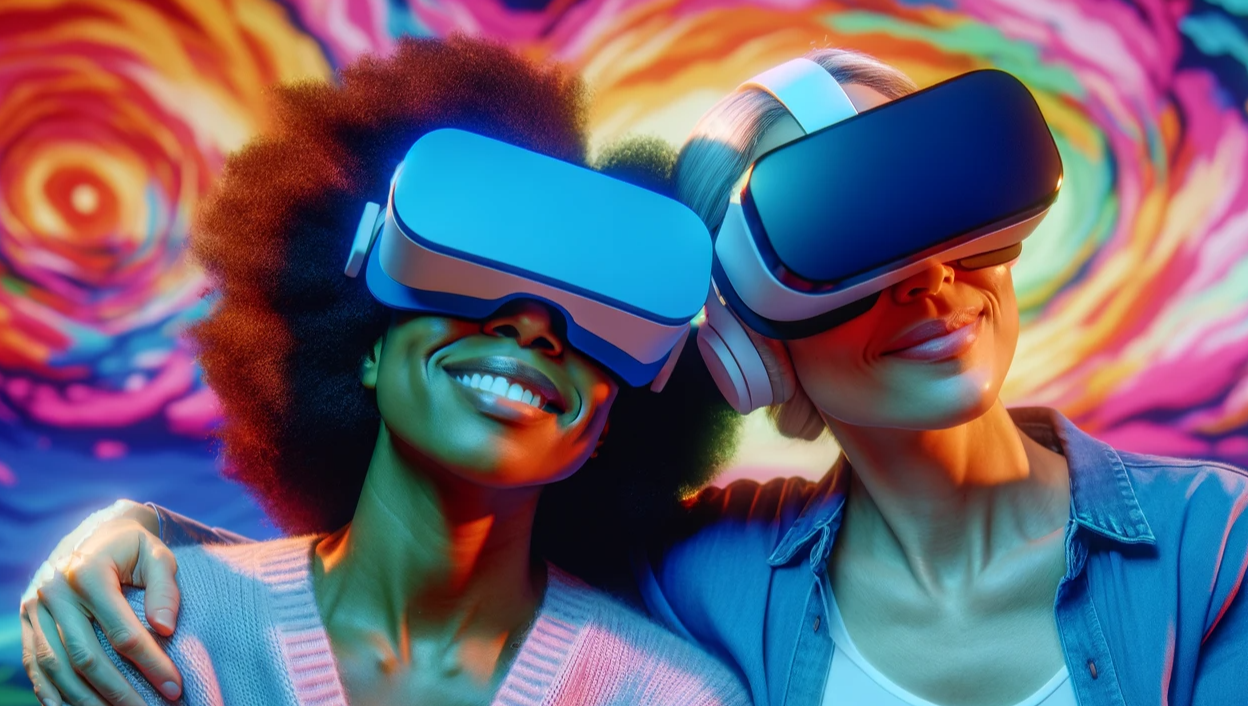Virtual reality is ready to transform how we study and treat human sexuality.
Yet, despite gaining significant traction in psychology, the application of this immersive technology in clinical sexology remains relatively untapped.
To jumpstart research in this area, a group of scientists reviewed the existing literature on VR and sexual dysfunctions and published their findings in a November 2023 article for the journal Current Sexual Health Reports.
“Well-developed technologies, in collaboration with clinicians, researchers, and industry experts, have the potential to revolutionize traditional sex therapy,” said lead author David Lafortune, Ph.D., a Professor at the Department of Sexology at Université du Québec à Montréal.
“This is especially crucial for specific populations, including those experiencing infrequent partnered sex or its absence, issues related to geolocation and mobility, and limited access to specialized clinics.”

What is virtual reality?
Virtual Reality—or VR—is a technology that creates computer-generated and immersive characters and environments that feel like real life. It does so by providing users with a mix of stimuli mimicking non-VR experiences, such as sights, sounds, and even touch sensations.
VR combines both software and hardware to create virtual worlds. Software may include a collection of programs (data and instructions) telling a computer to display a virtual room with a potential sexual partner lying on a bed, invitingly. Hardware, on the other hand, may include controllers for interaction, as well as headsets with screens and speakers for 3D visual and auditory experiences.
The review
The scoping review examined 43 papers on the application of VR in sexology, focusing on sexual dysfunctions, response, satisfaction, and skills. Published from 1993 to 2023, they included theoretical, empirical, and conceptual studies.
Here are some of the key findings.
Getting intimate and aroused in virtual reality
Research reveals that VR’s immersive nature can enhance sexual arousal and foster a deeper sense of presence.
One study discovered that computer-generated characters were perceived as more attractive and engaging in VR than in regular 2D images.
Another study found participants felt more aroused and a stronger sense of intimacy with adult performers after watching them in VR compared to on flat screens.
Research also suggests that using first-person perspectives in VR simulations, which make someone feel they are inside a character, can increase sexual excitement. This was especially true when the user was touched in erogenous areas by another virtual character that matched their sexual interests.
Sex education for people with disabilities

VR could make sex education more accessible, including for people with intellectual and developmental disabilities, a group that is at a higher risk of experiencing sexual abuse and sexually transmitted infections.
A five-week course with a 20-minute VR game aimed at promoting healthy sexual relationships showed promising results. Three-quarters of the participants with disabilities found the virtual scenarios enjoyable, easy to use, and helpful.
VR for evaluating sexual offenders
VR could play a role in assessing sexual offenders
Three studies observed that people who have sexually abused children showed more sexual arousal and interest in child-like 3D characters compared to people who have not committed such offenses.
The immersive technology also offers a safer way to assess men with histories of sexual assault.
In one study, single men interacted with a virtual woman in dating simulations. Men with a history of sexual aggression were more likely to pressure the virtual character for sex and hold stereotypical beliefs that justified forcing sex. They also tended to give her more alcohol compared to non-aggressive men.
Another study using the same simulation compared men who had sexually assaulted women who were drinking to those who targeted sober women as well as men who had not committed sexual assault. The findings showed that men who assaulted intoxicated women gave more alcohol to the virtual character and perceived her as more sexually open due to alcohol.
Sexual assault awareness and helping survivors

VR-based treatments may also help survivors of sexual violence cope with trauma. Not only does research reveal VR can help identify symptoms of post-traumatic stress disorder (PTSD), it may also help treat the condition.
One study successfully reduced PTSD and depression symptoms in veterans with sexual trauma using VR therapy with lasting effects. Another compared VR therapy to traditional therapy for PTSD in veterans with childhood abuse, finding both methods equally effective in reducing symptoms.
Researchers are also exploring how VR role-plays can improve understandings of women’s reactions to sexual pressure and teach ways to resist sexual attacks.
A 90-minute VR program was specifically designed to teach high school girls assertive resistance techniques against sexual coercion. Post-training, girls honed these skills through VR role-playing. Three months following the program, the participants reported a decrease in sexual victimization compared to their peers who did not undergo the training.
Erectile disorder and premature ejaculation
Published between 1997 and 2004, a series of studies led by Italian physician Gabriele Optale reveal the potential of VR to treat erectile dysfunction and premature ejaculation.
More than 80% of participants with erectile disorder and 73% with premature ejaculation experienced significant improvements after receiving VR-assisted psychodynamic therapy. In a control group, only 29% to 50% of participants with erectile disorder reported total or partial improvement.
A follow-up study on a 25-week treatment program showed positive effects lasted for at least 12 months in 47% to 76% of individual with erectile disorder and 54% with premature ejaculation
Exploring VR-based treatments for orgasm disorder and painful sex
Similar to how VR is being used to treat anxiety, pain, and eating disorders, this technology could be used for sexual therapy, especially for treating genital pain disorders or sexual dysfunctions where anxiety is a major factor.

Researchers are also exploring the potential of VR to treat female orgasmic disorder and vaginismus, which in this case is defined as the fear of painful vaginal penetration.
Data from a pilot study called Sextreatverse, which used an avatar-based VR protocol, suggests the therapy could help people who have difficulty reaching orgasms. This form of treatment may also give patients a greater sense of privacy and safety.
The VIVID study at UBC Sexual Health Research explored how people with and without vaginismus react emotionally to sexual VR videos with the goal of creating a VR-based treatment.
“We found that compared to women without vaginismus, those with vaginismus experienced much higher rates of general presence, sexual presence, and anxiety when watching the VR erotica,” Principal Investigator Dr. Lori Brotto told le Shaw.
The paper sharing the full results is not yet published. However, Dr. Brotto confirmed her research lab is carrying out a follow-up study to compare responses to live actors versus computer-generated avatars in virtual reality.
“The advantage of the latter is that you can customize body shapes, skin tones, other personal features, but what we don’t know is whether the avatars compromise on feelings of sexual presence,” Brotto added.
After obtaining the findings from this study, the team plans to launch VIVID 2.0 in Fall 2024. They will test their most effective VR stimuli in a real clinic setting, allowing participants to use a vaginal insert with the VR headset.
VR exposure therapy for sexual aversion disorder
Sexual Aversion Disorder (SAD) is a psychological condition where people persistently feel intense fear, anxiety, or disgust toward sexual contact or activities. This can cause problems in personal relationships.
Dr. Lafortune led studies to see how people with SAD react to virtual sexual situations. The findings suggest VR could help identify and assess sexual aversion symptoms in a clinic.
“As sexual interactions are impossible to recreate ethically in therapeutic settings, VR exposure therapy offers individuals with sexual aversion a new way to safely experience typically avoided sexual situations, and clinicians, a new tool to recreate, closely monitor, and provide symptom-adjusted exposure to different levels of sexual explicitness,” he said.
Dr. Lafortune and his team are now doing a study called EVAS to test four types of VR exposure-based therapy on people with diverse sexual and gender identities.
The future of VR in sex therapy
VR in sex therapy could do more than just change the game; it has the power to reinvent it.
With its ability to mimic real-life intimacy, VR can help identify specific triggers of sexual dysfunction and allow for treatment plans tailored to each person’s specific symptoms.
It also enables the creation of safe, simulated sexual scenarios that would be otherwise impossible or unethical in the real world. This positions VR sex therapy as a potentially better, more controlled alternative to traditional therapeutic methods of treating sexual dysfunction.
As it becomes more advanced and affordable, VR may offer more engaging and accessible options for exploring sexual responses, teaching sexual skills, and understanding the true depth of human desires.
Featured Image Source: AI-generated with DALL-E



